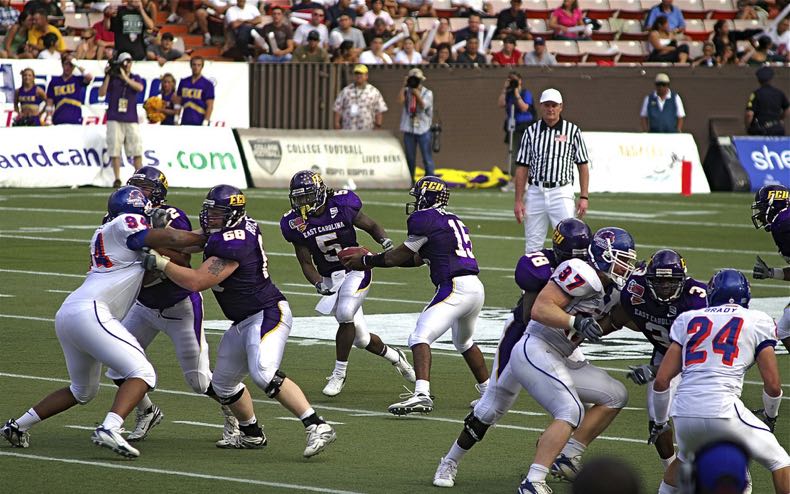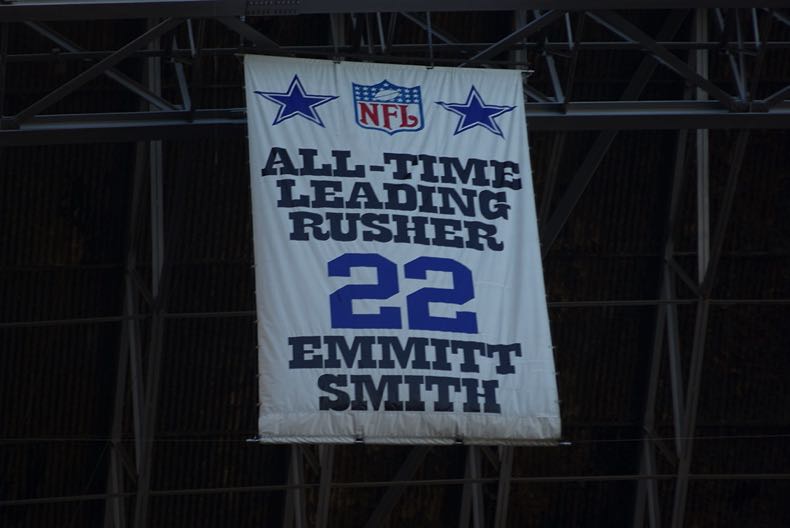 To the uninitiated, American football is a sport that is full of rules and regulations that can make it difficult to understand and even more difficult to bet on. And although it has far more stoppages, changes of personnel and (sometimes pretty darn confusing) rules than sports such as football (soccer), once you get the hang of the basics, it does tend to make sense.
To the uninitiated, American football is a sport that is full of rules and regulations that can make it difficult to understand and even more difficult to bet on. And although it has far more stoppages, changes of personnel and (sometimes pretty darn confusing) rules than sports such as football (soccer), once you get the hang of the basics, it does tend to make sense.
In this article, we’re focussing on a specific aspect of the sport, namely rushing yards. We’ll briefly explain what rushing yards are and we’ll go on to explain how to bet on them in an NFL match along with basic strategies you might like to employ to increase your chances of winning. We’ll then finish off with a few useful/useless (delete as you see fit) stats related to rushing yards.
What Is a Rush?

Mark Ramelb / Wikipedia.org
To understand rushing yards in American football, first you must understand what a rush is. We will assume you have watched an NFL match before and that you’re familiar with the most rudimentary elements of the game, i.e. two teams attempting to get the essentially rugby-shaped ball to the opponents’ end zone… or rugby with lots of padding in which forward passes are allowed, if you prefer. The team that is in possession of the football, that is the team on offense (we’ll retain the American English spelling here as it’s their sport!), begins their play from the line of scrimmage and the ball is usually passed backwards to the quarterback (which is known as the snap).
Run the Ball Forward to Gain Yardage
There are various options open to the quarterback at this point: among some others, they can opt to pass the ball forwards (a passing play), kick the ball (for example, when trying to score a field goal) or they can rush. When the team in offense chooses to rush it simply means they attempt to run the ball forwards to gain yardage (as opposed to throwing it forwards).
This might occur, for instance, when the quarterback is in possession of the ball and cannot find a receiver to pass to so attempts the run the ball forwards into space before he is sacked (tackled). Alternatively, it might be a planned play in which the QB hands off the ball to a player, most commonly the running back, for them to run towards the opposing team’s end zone. A third option would be for the quarterback to make a lateral pass (a pass that doesn’t go forwards) to a teammate who then runs the ball forwards.
So, What Are Rushing Yards?
Most American sports collect a lot of data and US sports fans love their stats. One of the stats that many people analyse when it comes to the NFL is the rushing yards. The rushing yards stats refers to how many yards a player or team has carried the ball forwards beyond the line of scrimmage from running plays. Note that the rushing yards stats are given as net figures, so if – for instance – a player runs the ball backwards or gets tackled before they’ve made it past the original line of scrimmage, they will be awarded a minus figure for that play. For example, considering the following two plays:
- The QB hands the ball off to the running back when 10 yards behind the line of scrimmage. The running back dodges the oncoming tackles and runs the ball a full 50 yards towards the opposing team’s end zone, thus 40 yards beyond the line of scrimmage.
- The QB once again hands the ball off to the running back 10 yards behind the line of scrimmage, but this time it’s something of a hospital pass as two opponents immediately pummel him to the ground while he’s still 10 yards short of the line of scrimmage.
Based on the above two plays, the running back in question would have made a net total of 30 rushing yards, i.e. 40 minus 10. Note that while player rushing yards are perhaps the most relevant stat relating to rushing (at least when punters are seeking out bets) various other rushing-related stats are collected by various organisations or broadcasters on NFL matches including such things as the percentage of plays that involve rushing, the number of rushing attempts, the number of yards gained per rushing attempt and the number of rushing touchdowns per game.
What Is a Pass Rush?
Note that the rush in relation to rushing yards is not the same thing as a pass rush. While a rush is something the team in offense does on their play, the pass rush is something undertaken by the defensive side as they run across the line of scrimmage after the snap and attempt to sack the quarterback before they get their pass away.
Betting on Rushing Yards

hkratky / Bigstockphoto.com
Unlike with some other aspects of American football (notably touchdowns), there are not too many betting markets relating to rushing yards. Betting on rushing yards is an example of a player prop (or proposition) bet. In other words, you are betting on something other than the actual outcome of the game, and though it could have an effect on the overall outcome, your bet can usually win or lose irrespective of the result of the match itself.
Player Rushing Yards
The most common betting market relating to rushing yards is Player Rushing Yards. In this market, as the name suggests, punters can bet on specific players in a given game. This is usually presented in an over/under format whereby the number of yards is given with an extra half yard to make sure it is a win or lose bet with no possibility of a draw – a concept many American struggle with.
To give an example of such a market, we’ll give the Player Rushing Yards odds available on a number of players ahead of Super Bowl LVI (played in February 2022 between the Los Angeles Rams and the Cincinnati Bengals):
| Player | Rushing Yards (Over/Under) | Example Odds |
|---|---|---|
| Ja’Marr Chase | Under 3.5 | 17/20 |
| Ja’Marr Chase | Over 3.5 | 5/6 |
| Cam Akers | Under 62.5 | 9/10 |
| Cam Akers | Over 62.5 | 9/10 |
| Cam Akers | Under 65.5 | 5/6 |
| Cam Akers | Over 65.5 | 5/6 |
| Joe Mixon | Under 62.5 | 5/6 |
| Joe Mixon | Over 62.5 | 5/6 |
| Ja’Marr Chase | Under 4.5 | 5/6 |
| Ja’Marr Chase | Over 4.5 | 5/6 |
| Matthew Stafford | Under 5.5 | 5/6 |
| Matthew Stafford | Over 5.5 | 5/6 |
| Joe Burrow | Over 12.5 | 5/6 |
| Joe Burrow | Under 12.5 | 5/6 |
As you can see, in most cases the bookies set the over/under levels so that they think both outcomes have a roughly equal chance of occurring. Then, of course, they build in a margin by offering odds of less than evens on each outcome. Sometimes bookies also offer two or more options, usually referred to as alternative lines, (as with Cam Akers above) with odds that are altered accordingly.
The number of rushing yards in each case differs based on the perceived chances a player will perform well in that particular aspect of the game. So, for instance, for a player like running back Joe Mixon who has posted the third-best total of rushing yards in the 2021 regular season and best in the post-season (190), the over/under line is 62.5 rushing yards. Whereas for a player like quarterback Matthew Stafford, the line is much lower on account of him tending to pass rather than run (and his post-season rushing yards total of 36 yards).
Player Rushing Yards & Receiving Yards
As well as betting on the number of rushing yards a player makes in a given game, this can also be combined with the number of receiving yards. Receiving yards are the number of yards gained by a player after the ball has been passed (forwards) to him. Note that we’ll be covering the technicalities of receiving yards in a separate article so we won’t delve too deeply into it here.
As with the above-mentioned betting market, this is usually offered as an over/under bet with odds just shy of even money for each option. The totals expected tend, of course, to be significantly higher when combining these two stats, as can be seen from the example odds below.
| Player | Rushing & Receiving Yards (Over/Under) | Example Odds |
|---|---|---|
| Cam Akers | Under 82.5 | 5/6 |
| Cam Akers | Over 82.5 | 5/6 |
| Cam Akers | Under 83.5 | 5/6 |
| Cam Akers | Over 83.5 | 5/6 |
| Joe Mixon | Under 91.5 | 5/6 |
| Joe Mixon | Over 91.5 | 5/6 |
In this case, the number of players featured is reduced and is limited to the main running backs. As well as their primary role as runners, these players can and often do receive passes from the QB. The different over/under lines in this case (82.5 and 83.5) are offered at the same odds but by two different bookies. In this case, the bookmakers have taken very slightly different positions on how many combined rushing and receiving yards Akers will make and it is common to see at least a little variability between the main betting sites.
Strategies for Rushing Yards Betting
As with bets on most sports, studying the available statistics and seeking out betting value is the key to making a positive return from your punts on American football and rushing yards in particular. Thankfully, there is a plethora of statistics available on the NFL’s official website, including lots of statistics on players’ rushing yards.
An example of seeking out a value bet on rushing yards would be to first work out the expected number of rushing yards a player will make; then work out whether the odds offered on them making over a specific number of rushing yards implies a greater or lesser implied probability than the stats suggest.
Looking at a real-world example, as mentioned above, Cincinnati Bengals’ running back Joe Mixon is priced at odds of 5/6 to make over 62.5 rushing yards in Super Bowl LVI on 13th February 2022. (Incidentally, he’s the same price to make under 62.5 rushing yards.) Odds of 5/6 imply a probability of 45.45%; as such, if you can ascertain the true probability of Mixon making over 62.5 rushing yards (or under 62.5 rushing yards, for that matter, given that option is also available the same odds), you have yourself a value bet.
Looking at the Stats
The most logical and easiest way to work out the true probability (or let’s say “true” probability, as there are many potential confounding variables) is to take a look at the stats. If we keep things simple and look at Mixon’s post-season rushing yards, he’s made 190 in three post-season games, an average of 63.3 per game. In those three games he made 88 rushing yards in one game, 54 in another and 48 in the third. So two out of his last three matches saw him make under 62.5 rushing yards. Based on a simple calculation using those stats alone, you would say that he would have a 66.67% chance of making under 62.5 rushing yards in his next game and hence the under 62.5 bet would be the one classed as “value”.
Examining Variables
Of course, a sample size of three is tiny and certainly not one that should be used to draw any firm conclusions (in other words, don’t put your house on it!). This is especially the case given that there are so many variables in sports in general, including things like the weather conditions, how much sleep the player had the night before the game, their psychological state, whether opposing players are particularly effective at stopping them, and so on.
Taking into Account Regular Season Games
It’s also worth noting, in this particular case of Joe Mixon, if we take into account his regular-season games (in which he made 1,205 rushing yards over 16 games, an average of 75.31 rushing yards per game), he actually made over 62.5 rushing yards in 12 out of 19 (regular season plus post-season) games. This would give an implied probability of 63.16% that he will make over 63.5 rushing yards at the Super Bowl. Hence, based on the full season, the value bet would be the overs. It suddenly becomes easy to see why calculating the real probabilities of a sporting outcome is far from an easy task.
NFL Rushing Stats & Records

Big Cowboy Kev / Wikipedia.org
At the time of writing (just ahead of Super Bowl LVI), a total of 31 players have amassed more than 10,000 rushing yards. Of these, the undisputed rushing yard legend is the brilliant Emmitt Smith, who gained more than 18,000 rushing yards over the course of his illustrious career. He also holds the record for the most post-season rushing yards (1,586) and he’s second in the list of all-time rushing touchdown scorers with 175 to his name.
Top 10 Players with the Most All-Time Rushing Yards
| Player | Years | Team(s) | Number of Carries | Total Number of Yards |
|---|---|---|---|---|
| Emmitt Smith | 1990-2004 | Dallas Cowboys, Arizona Cardinals | 4,409 | 18,355 |
| Walter Payton | 1975-1987 | Chicago Bears | 3,838 | 16,726 |
| Frank Gore | 2005-2020 | San Francisco 49ers, Indianapolis Colts, Miami Dolphins, Buffalo Bills, New York Jets | 3,735 | 16,000 |
| Barry Sanders | 1989-1998 | Detroit Lions | 3,062 | 15,269 |
| Adrian Peterson | 2007-2022 | Minnesota Vikings, New Orleans Saints/Arizona Cardinals, Washington Redskins, Detroit Lions, Tennessee Titans, Seattle Seahawks | 3,230 | 14,918 |
| Curtis Martin | 1995-2005 | New England Patriots, New York Jets | 3,518 | 14,101 |
| LaDainian Tomlinson | 2001-2011 | San Diego Chargers, New York Jets | 3,174 | 13,684 |
| Jerome Bettis | 1993-2005 | St Louis/LA Rams, Pittsburgh Steelers | 3,479 | 13,662 |
| Eric Dickerson | 1983-1993 | LA Rams, Indianapolis Colts, LA Raiders, Atlanta Flacons | 2,996 | 13,259 |
| Tony Dorsett | 1977-1987 | Dallas Cowboys, Denver Broncos | 2,936 | 12,739 |
